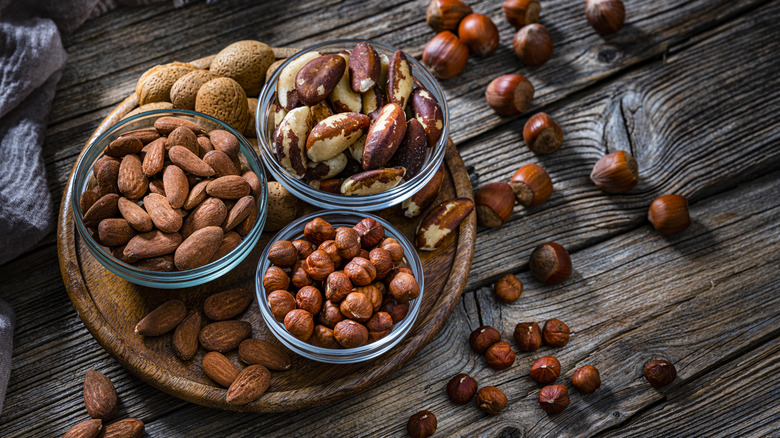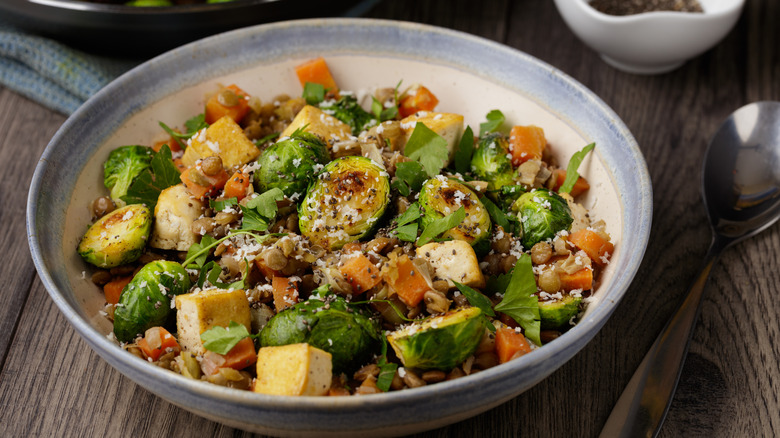Everything You Want To Know About The Portfolio Diet
If you've been struggling with high cholesterol lately, the portfolio diet could be for you. Though it isn't actually a diet in the traditional sense, it's named so because it has a select "portfolio" of foods you incorporate into your everyday diet. This is in stark contrast to typical diets that require you to cut a lot out, for example, the keto diet.
Developed by Toronto-based doctor David Jenkins, who also invented the glycemic index (a tool to understand how carbs affect blood glucose levels), the portfolio of foods chosen have all been proven to lower cholesterol. If left untreated, high cholesterol can lead to an increased risk of heart attacks and strokes, which is why it's so important to keep your cholesterol at a healthy level. Some doctors will ask you to try and lower your cholesterol levels by yourself before prescribing medication, and the portfolio diet could be helpful in this regard.
Though the portfolio diet is not an all-in diet, you still shouldn't jump straight in without doing your own research. Lifestyle changes won't give the same results to everybody, and doing what's best for your health should always come first. Here's everything you need to know about the portfolio diet and whether it could be right for you.
By incorporating these ingredients, you could see a huge change
The main ingredients in the portfolio diet are nuts, plant protein, plant sterols, and viscous fiber. You should aim for 45g of nuts per day, so you could have them as snacks or sprinkled on top of meals. For plant protein, aim for 50g daily. For plant sterols, the recommendation is 2g a day. When it comes to viscous fiber, the portfolio diet says you should have two servings of beans, lentils, chickpeas, and oatmeal daily. Additionally, you should have two servings of cereals containing barley or oat bran per day.
If you're not sure what to eat for plant protein, tofu and soy, including soy milk and soybeans are solid choices. As for nuts, almonds, pistachios, and almonds are all good options. If you don't think you can eat 45g of whole nuts, try nut butters instead. Plant sterols are found in foods by themselves, but look for fortified fat spreads or mini yogurt drinks to make sure you're getting the recommended amount.
Moreover, there are plenty of other foods you can eat on the portfolio diet that aren't part of the core four, including fruits like apples and oranges and vegetables such as eggplant, all of which contain viscous fiber.
Here are some of the foods you should aim to eat
You may have noticed that all the foods mentioned so far are plant-based. As the portfolio diet doesn't follow the same rules and regulations as a structured diet, it cannot specifically be called a plant-based diet. Nevertheless, it is recommended that when following the portfolio diet, you eat less of certain foods known to cause high cholesterol such as red meat, butter, and certain cheeses. It's also recommended that you cut down on refined carbs like white bread. Instead of white bread, eat whole grain oat breads or oatcakes.
So, how effective is it? A 2014 study researching the portfolio diet found that those following this way of eating for six months had notably decreased cholesterol levels. Additionally, a 2005 study showed that the diet is equally as good at reducing unhealthily high cholesterol levels as statins, a medication specifically designed to reduce cholesterol.
You should start small when making any sort of diet change, but especially with the portfolio diet. It isn't an all-in kind of meal plan, but one that should be incorporated slowly and built up. However, if you want to lower your cholesterol yourself without the aid of medication, starting the portfolio diet could be the change you need.


